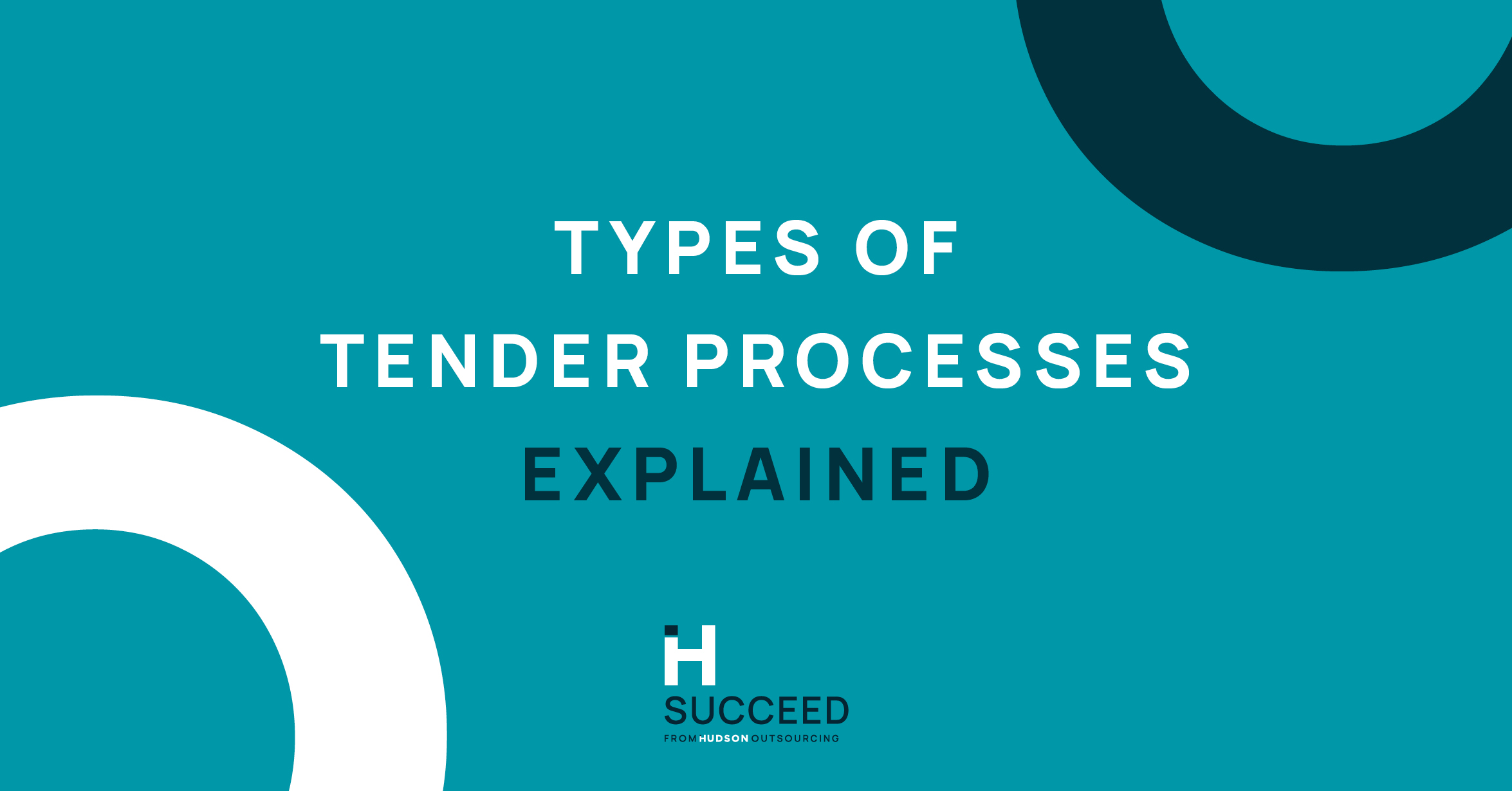Let’s explore the different types of tender procedures…
Are you familiar with the different types of tender procedures?
The tendering process can be incredibly complex and time-consuming. If you’re new to tendering for contracts, you might not know where to start!
However, you’re in luck! In this blog, we’ll outline the different types of tender procedures. So, when you start tendering for work, you’ll be more than ready to tackle the bid!
What are the different types of tender procedures?
Open tendering
One of the most common types of tender procedures is open tendering. With this method, the buyer is allowing any business to bid for the contract.
A typical open tendering process would include the following:
Typically, the process will begin when the buyer releases an invitation to tender (ITT). Once this document is published, any business can respond and bid for the work.
To be successful, prospective suppliers are expected to submit a tender response that sells their business to the buyer.
The next stage is for buyers to evaluate the tender responses and award the contract to their chosen supplier. Usually, the buyer will award the contract to the most economically advantageous tender, or the MEAT.
It’s also common for buyers to disclose a price vs quality weighting in the tender documents. For example, they will evaluate tenders on the basis of 30% quality and 70% price.
Restricted tendering
As well as open tendering, there are other types of tender procedures out there, such as restricted tendering. This is also known as selective tendering.
This service is more likely to be used when the buyer wishes to acquire complex or specialist services. With restricted tendering, only suppliers that have been invited directly by the buyer can tender for the work. As a result, the buyer can shortlist the suppliers to filter through any that don’t meet their requirements.
This type of tendering procedure could include the following steps:
Negotiated tendering
One of the types of tender procedures that you might come across is negotiated tendering. As the name suggests, this process involves a negotiation between the buyer and prospective suppliers.
This process might include the following stages:
This type of tender will usually start with a pre-qualifying stage. For example, the buyer might ask suppliers to complete a PQQ or SQ.
Once the suppliers have been shortlisted, they receive an invitation to negotiate. Unlike the other types of tender procedures, there are no set guidelines for this process. In some cases, negotiations can continue until after the preferred supplier is appointed.
Remember, these are just some of the different types of tender processes out there. This list is not exhaustive – you could be faced with many more on your tendering journey!
What are the different types of tender documents?
During our exploration of different tender processes, we briefly touched on ITTs, PQQs and more. You might have heard these terms before, but do you know what they mean?
Understanding the different types of tender documents is just as important as understanding the different tender processes. So, let’s look at each term in more detail…
PQQ stands for pre-qualification questionnaire. Generally, this document is used to pre-qualify suppliers before they submit a formal bid.
Typically, PQQs will cover the status of your organisation, finances, how you manage quality, your company’s policies, and case studies.
SQ stands for selection questionnaire. This document is very similar to a PQQ, however, there are some key differences.
For example, with PQQs, the buyer will generally expect evidence of your qualifications and certificates. However, this is not always the case with an SQ. Instead, the buyer might ask for evidence of this at the ITT stage of the tendering process.
As we’ve already established, ITT stands for invitation to tender. This is one of the most common types of tender documents that you’ll face during the process.
An ITT is a formal document issued by a buyer, outlining the scope of their project. This document is used to invite organisations or individuals to submit a formal tender for the work.
In summary
Now you know some of the different types of tender processes out there. You could be faced with open tendering, restricted tendering or negotiated tendering. But remember, this list is not exhaustive – there are many types of tender procedures out there.
It’s also important to remember the different types of tender documents you might come across. Buyers might ask you to complete a PQQ or SQ. This helps them to filter through prospective suppliers before they’re formally invited to tender – which brings us to another document! More than likely, the buyer will ask you to respond to an ITT. This allows them to evaluate suppliers and choose the right one for their project.
How Hudson Succeed can help
Still have questions about the types of tender processes and procedures? Why not call our Bid Writing Consultants? We’re always happy to help!
We have over 60 years of bid writing experience and an 87% success rate. Whether you’re completely new to tendering or aren’t seeing results – we can help. There are four bid writing packages available:
Once you’ve found a tender you’d like to go for, send it over to us. One of our Bid Writers will write the tender response for you. We’ll provide a full Tender Writing breakdown and even submit it on your behalf.
Tender Mentor can give your tender response a once over before you submit. Our Bid Writing Team will analyse your response, notifying you of any errors and opportunities for improvements prior to submission.
During the Tender Ready service, our team will create professional policies, procedures, and case studies in your company branding. If you already have this content, we will review everything carefully to ensure that nothing is missed. This service also helps businesses who are new to tendering with terminology and industry knowledge.
The Tender Improvement package can help those who have tendered before but aren’t seeing results. Our Bid Writers will assess your previous responses and work with you to develop improved content.
Get in touch to find out how we can help your business grow.
Need help searching for tenders?
Now you know about the different tendering procedures, it’s time to find a contract opportunity for your company.
You may be wondering where you can find a tender for your business. There’s no shortage of websites offering multi-sector tendering opportunities and leads.
Ideally, you should be searching for a sector-specific site that posts all unique, public and private sector opportunities.
Our sister company, Hudson Discover, has 11 sector-specific tendering portals. One centralised and easy-to-navigate portal can help you save time, streamlining the process.
Once signed up, you’ll have access to your own dedicated Account Manager. They’ll be able to answer any questions you may have about public sector contracts. You’ll also get an email alert when new and relevant tenders are uploaded to your sector.
A subscription to one of our industry-specific portals will include:
- Unlimited portal access. You can browse your industry’s portal to your heart’s content. See the hundreds of opportunities that are available, intuitively categorised and easily accessible.
- A daily email bulletin. When you sign up to a portal, you’ll receive an email alert when new tenders are uploaded.
- A dedicated Account Manager. They’ll handle any questions or queries you may have about the portal.
- A free 20-minutes phone consultation with a Bid Writer. Our expert bid consultants will chat with you about anything tender related.
What opportunities can I expect from a tender search on a Hudson Discover portal?
We host all kinds of tenders in both the public and private sectors. These are inclusive of, but aren’t limited to:
Vocal
Our support doesn’t end there! Our creative content agency, Vocal, are on hand to help.
The Vocal Team are not afraid to stand up and be heard. And we make sure our clients aren’t either! From small, micro businesses to large organisations, we are vocal about the things that make your business unique.
Our creative service is dedicated to growing your business through striking and thought-provoking content. We’ll take your bid and give it a complete makeover. With professionally designed tender documents, you’re sure to make an impression on the buyer!
Our team specialise in six areas, including:
If you’d like to know more about what we can do for your business, introduce yourself to the team!
Contact us to find out more!
Find more helpful tips and advice in our blogs. We cover topics including:





